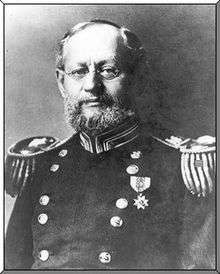Henry Martyn Robert
Henry Martyn Robert (May 2, 1837 – May 11, 1923) was an American soldier, engineer, and author. In 1876, Robert published the first edition of his manual of parliamentary procedure, Robert's Rules of Order, which remains today the most common parliamentary authority in the United States.
Henry Martyn Robert | |
|---|---|
 Henry Martyn Robert | |
| Born | May 2, 1837 Robertville, South Carolina |
| Died | May 11, 1923 (aged 86) Hornell, New York |
| Buried | |
| Allegiance | United States of America |
| Service/ | United States Army Union Army |
| Years of service | 1857–1901 |
| Rank | |
| Commands held | Chief of Engineers |
| Battles/wars | Pig War American Civil War |
| Other work | author of Robert's Rules of Order |
Life and career
Robert was born in Robertville, South Carolina, and raised in Ohio, where his father moved the family because of his strong opposition to slavery. Robert's father, Reverend Joseph Thomas Robert, later became the first president of Morehouse College where there is a dormitory on the campus named after him. Robert was nominated to West Point from Ohio, and graduated fourth in his class in 1857. He became a military engineer.
Under command of Silas Casey during the Pig War he built the fortifications on San Juan Island. In the American Civil War, he was assigned to the Corps of Engineers and worked on the defenses of Washington, D.C., Philadelphia, and several New England ports.
Robert served as Engineer of the Army's Division of the Pacific from 1867 to 1871. He then spent two years improving rivers in Oregon and Washington and six years developing the harbors of Green Bay and other northern Wisconsin and Michigan ports. He subsequently improved the harbors of Oswego, New York, Philadelphia, and Long Island Sound and constructed locks and dams on the Cumberland and Tennessee rivers. From 1890 to 1891 he served as a member of the Board of Commissioners for the District of Columbia. As Southwest Division Engineer from 1897 to 1901, Robert studied how to deepen the Southwest Pass of the Mississippi River.
Robert was president of the Board of Engineers from 1895 to 1901. He received a tombstone promotion to brigadier general on April 30, 1901, and was appointed Chief of Engineers. He served until May 2, 1901, when he retired from the Army. Following his retirement, he chaired a board of engineers that designed the Galveston, Texas seawall following the Galveston Hurricane of 1900.
He died in Hornell, New York, and is buried at Arlington National Cemetery.
He is most famous for his Pocket Manual of Rules of Order for Deliberative Assemblies (later known as "Robert's Rules of Order") —a collection of rules regarding parliamentary procedure, published in 1876.[1] He wrote the manual in response to his poor performance in leading a church meeting that erupted into open conflict because of concerns about local defense at the First Baptist Church, 149 William Street in New Bedford, Massachusetts. He resolved that he would learn about parliamentary procedure before attending another meeting.[2] The rules are loosely based on procedures used in the United States House of Representatives, but the rule book was not intended for use in national and state legislatures. At the time, Robert was a resident of Haworth, New Jersey.[3]
Bibliography
- Pocket Manual of Rules of Order for Deliberative Assemblies ("Robert's Rules of Order"). Chicago: S. C. Griggs & Company. 1876.
- Robert's Rules of Order Revised for Deliberative Assemblies. Chicago: Scott, Foresman and Company. 1915.
- Parliamentary Practice: An Introduction to Parliamentary Law. New York: Century Co. 1921.
- Parliamentary Law. New York: Century Co. 1923.
References
- Edson, Arthur (August 27, 1954). "Tribute Paid Man Who Wrote Rules of Order". Google News Archive Search. Daytona Beach Morning Journal (via the AP). Retrieved 2015-12-02.
- "Historical Vignette 038 - An Army Engineer Brought Order to Church Meetings". U.S. Army Corps of Engineers - Office of History. November 2001. Retrieved 2015-12-02.
- Staff. "Copyright Notices", p. 164. The Publishers' Weekly, Volume 65, Part 1, January 30, 1904. Accessed December 4, 2014. "To wit: Be it remembered, That on the 2d day of January, 1904, Henry M. Robert of Haworth, N. J., hath deposited in this office the title of a book, the title of which is in the following words, to wit: Pocket Manual of Order for Deliberative Assemblies Part I of Order A compendium of Parliamentary law based upon the rules and practice of Congress."
Sources
This article contains public domain text from "Brigadier General Henry M. Robert". Portraits and Profiles of Chief Engineers. Archived from the original on March 6, 2005. Retrieved June 17, 2005.
External links
| Wikisource has original works written by or about: Henry Martyn Robert |
- ROBERT, Henry Martyn - The Handbook of Texas Online
- Works by Henry Martyn Robert at Project Gutenberg
- Robert's Rules of Order at Project Gutenberg
- Works by or about Henry Martyn Robert at Internet Archive
- Works by Henry Martyn Robert at LibriVox (public domain audiobooks)

- Henry Martyn Robert at Find a Grave
| Military offices | ||
|---|---|---|
| Preceded by John Moulder Wilson |
Chief of Engineers 1901 |
Succeeded by John W. Barlow |